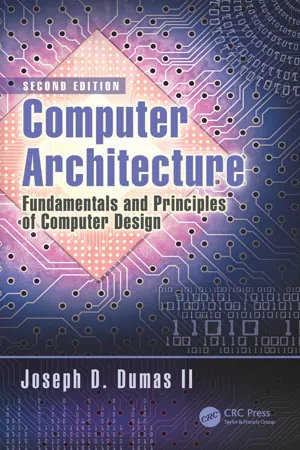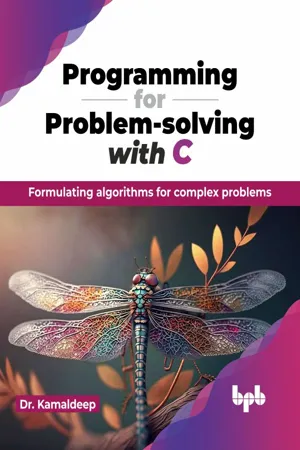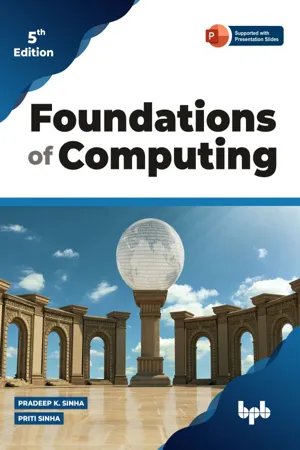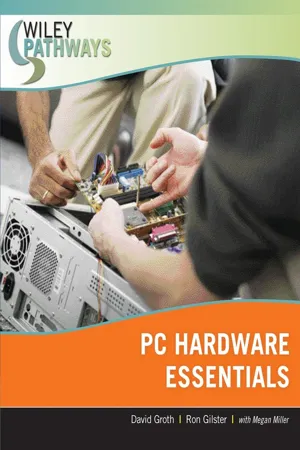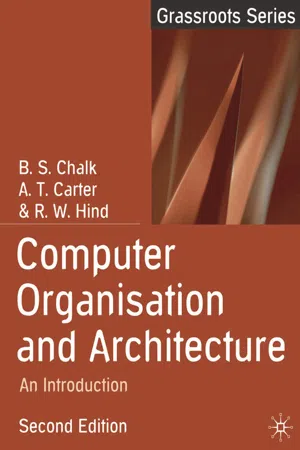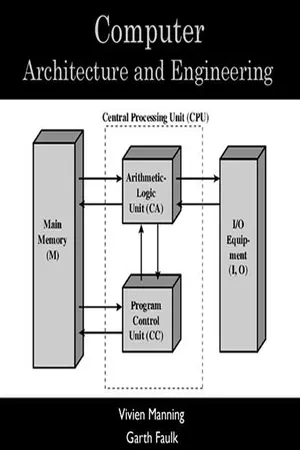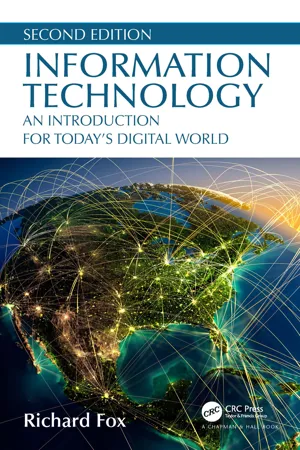Computer Science
CPU Function
The CPU (central processing unit) is the primary component of a computer that performs instructions and processes data. It carries out arithmetic, logic, and input/output operations as directed by the computer's software. The CPU's function is to execute program instructions and coordinate the activities of the computer's other hardware components.
Written by Perlego with AI-assistance
Related key terms
1 of 5
12 Key excerpts on "CPU Function"
- eBook - PDF
Computer Architecture
Fundamentals and Principles of Computer Design, Second Edition
- Joseph D. Dumas II(Author)
- 2016(Publication Date)
- CRC Press(Publisher)
chapter three Basics of the central processing unit The central processing unit (CPU) is the brain of any computer system based on the von Neumann (Princeton) or Harvard architectures intro-duced in Chapter 1. Parallel machines have many such brains, but normally each of them is based on the same principles used to design the CPU in a uniprocessor (single CPU) system. A typical CPU has three major parts: the arithmetic/logic unit (ALU), which performs calculations; internal reg-isters, which provide temporary storage for data to be used in calculations; and the control unit, which directs and sequences all operations of the ALU and registers as well as the rest of the machine. (A block diagram of a simple CPU is shown in Figure 3.1.) The control unit that is responsible for carrying out the sequential execution of the stored program in memory is the hallmark of the von Neumann–type machine, using the registers and the arithmetic and logical circuits (together known as the datapath ) to do the work. The design of the control unit and datapath have a major impact on the performance of the processor and its suitability for various types of applications. CPU design is a critical component of overall system design. In this chapter, we look at important basic aspects of the design of a typical general-purpose processor; in the following chapter, we will go beyond the basics and look at modern techniques for improving CPU performance. 3.1 The instruction set One of the most important features of any machine’s architectural design, yet one of the least appreciated by many computing professionals, is its instruction set architecture (ISA). The ISA determines how all software must be structured at the machine level. - eBook - ePub
Computer Architecture
Fundamentals and Principles of Computer Design, Second Edition
- Joseph D. Dumas II(Author)
- 2016(Publication Date)
- CRC Press(Publisher)
chapter threeBasics of the central processing unit
The central processing unit (CPU) is the brain of any computer system based on the von Neumann (Princeton) or Harvard architectures introduced in Chapter 1 . Parallel machines have many such brains, but normally each of them is based on the same principles used to design the CPU in a uniprocessor (single CPU) system. A typical CPU has three major parts: the arithmetic/logic unit (ALU), which performs calculations; internal registers, which provide temporary storage for data to be used in calculations; and the control unit, which directs and sequences all operations of the ALU and registers as well as the rest of the machine. (A block diagram of a simple CPU is shown in Figure 3.1 .) The control unit that is responsible for carrying out the sequential execution of the stored program in memory is the hallmark of the von Neumann–type machine, using the registers and the arithmetic and logical circuits (together known as the datapath ) to do the work. The design of the control unit and datapath have a major impact on the performance of the processor and its suitability for various types of applications. CPU design is a critical component of overall system design. In this chapter, we look at important basic aspects of the design of a typical general-purpose processor; in the following chapter, we will go beyond the basics and look at modern techniques for improving CPU performance.3.1 The instruction set
One of the most important features of any machine’s architectural design, yet one of the least appreciated by many computing professionals, is its instruction set architecture (ISA). The ISA determines how all software must be structured at the machine level. The hardware only knows how to execute machine language instructions, but because almost all software is now developed in high-level languages rather than assembly or machine language, many people pay little or no attention to what type of instruction set a machine supports or how it compares to those used in other machines. As long as the system will compile and run a C++ program or support a Java virtual machine, is its native machine language really all that important? If all you are concerned with is getting a given program to run, probably not. But if you are interested in making a system perform to the best of its abilities, then it behooves you to know what those abilities really are, and the only ability of a CPU that really matters is its ability to execute machine instructions. What those instructions are, what they do, and how they support your high-level task can have a great deal to do with how quickly and efficiently that task will be done. Thus, it is worthwhile to study the similarities and differences between ISAs in order to be able to pick the best system for a given application. We examine important features of computer ISAs in this section. - eBook - ePub
Programming for Problem-solving with C
Formulating algorithms for complex problems (English Edition)
- Dr. Kamaldeep(Author)
- 2023(Publication Date)
- BPB Publications(Publisher)
HAPTER 2The CPU and the Memory IntroductionThis chapter will delve into the heart of computer systems—the Central Processing Unit (CPU ) and its pivotal role in executing instructions. We will uncover the intricate workings of the CPU, the steps it takes to execute a single instruction, and the importance of CPU speed. Additionally, we will explore memory units, from the swift primary memory to the capacious secondary memory, and how they form the foundation of a computer’s memory hierarchy.Structure In this chapter, we will be discussing the following topics:- Central processing unit
- The instruction on CPU: working of CPU
- Steps performed for the execution of single instruction
- The CPU speed
- The memory unit
- Primary memory
- Secondary memory
- Memory hierarchy
- Measuring the memory
The objective of this chapter is to provide a comprehensive understanding of fundamental computer hardware components and their interplay. Readers will gain insights into the Central Processing Unit (CPU ) and its instruction execution process, grasp the significance of CPU speed, explore various memory units, comprehend memory hierarchy, and learn how to measure and manage computer memory effectively.The CPUThe process of operating on the data as per the command given by the user is called processing. The Central Processing Unit (CPU ) works as a processing unit in a computer. It performs the calculations and data processing operations on the data entered by the input device. It is also termed as the brain of the computer.Components of the CPU The major components of the CPU are as follows:- Arithmetic and logical unit (ALU )
- Control unit (CU )
- Set of registers
The arithmetic and logic unit is responsible for both arithmetic and logic functions. The arithmetic functions are addition, subtraction, multiplications, divisions, and so on, and the logical operations are AND , OR , NOT , and so on.CUThe control unit serves as the computer’s nervous system. It generates control signals that manage and control all computer components. For example, to add two numbers, it performs the following operation: - eBook - PDF
- Alvin Albuero De Luna(Author)
- 2023(Publication Date)
- Arcler Press(Publisher)
4.2. COMPUTER PROCESSORS Known as a “Microprocessor,” a processor is a tiny sort of chip that is used in computers and other electrical devices to do calculations. All basic instructions, like input/output (I/O), logical, arithmetical, and other basic instructions, which are generated by the hardware or the operating system (OS), are managed by the processor. Its primary job function is to collect input from input devices and then deliver correct results on output devices using that input. These days, more advanced processors are accessible on Dissecting Computer Architecture 136 the market, each of which is capable of controlling trillions of instructions in a single second (Darringer, 1969; Lazzaro et al., 1992). Processors are utilized in personal computers, but they may also be found in other electronic devices like smartphones, tablets, personal digital assistants, and other similar devices. Intel and AMD are the two major businesses that manufacture the highest-quality CPUs available on the market (Dulberger, 1993; Rao, 2019). 4.2.1. Basic Components of Processor • ALU: It is an arithmetic logic unit that aids in the execution of all logic and arithmetic operations. • FPU: It is also known as the “Math coprocessor,” and it aids in the manipulation of mathematical computations. • Registers: It saves the outcome of all operations and stores all instructions and data, as well as firing operands to the ALU. • Cache Memory: Aids to reducing the amount of time spent traveling data from the main memory (Figure 4.3). Figure 4.3. Components of CPU. Source: https://en.wikipedia.org/wiki/Central_processing_unit. Computer Processing and Processors 137 4.2.2. Primary Processor Operations • Fetch: In which to acquire all commands from the main memory unit (RAM). • Decode: This action is handled by the decoder, which converts all instructions into readable formats so that the other components of the CPU may continue with their activities. - eBook - PDF
- Greg Tomsho(Author)
- 2020(Publication Date)
- Cengage Learning EMEA(Publisher)
CPU Design We will discuss different design types of CPUs and various components of a CPU, but before we do, let’s take a look at its basic architecture. Most CPUs are composed of the following elements (see Figure 3-2): • Control unit—The control unit (CU) is the director of operations in the CPU. The control unit provides timing and coordination between the other parts of the CPU, such as the arithmetic logic unit, registers, and system bus. For example, when a new instruction should be executed, the control unit receives and decodes the instruction and tells the arithmetic logic unit to execute it. • Arithmetic logic unit—The arithmetic logic unit (ALU) performs the primary task of any CPU, which is to execute instructions. These might be arithmetic instructions, such as addition or multiplication of integers, or logic instructions, such as binary AND or binary OR instructions. Most CPUs also contain a floating-point unit (FPU) that performs floating-point operations. • Registers—A register is a temporary holding location on a CPU where data must be placed before the CPU can use it. There are instruction registers that hold the instruction the CPU executes, such as add, multiply, or store. Also, the CPU uses address registers to access data stored in RAM and data registers that hold the data the CPU is currently working with, such as two numbers used in an add or multiply instruction. MODULE 3 The Central Processing Unit (CPU) 114 Copyright 2021 Cengage Learning. All Rights Reserved. May not be copied, scanned, or duplicated, in whole or in part. Due to electronic rights, some third party content may be suppressed from the eBook and/or eChapter(s). Editorial review has deemed that any suppressed content does not materially affect the overall learning experience. Cengage Learning reserves the right to remove additional content at any time if subsequent rights restrictions require it. - eBook - ePub
Foundations of Computing
Essential for Computing Studies, Profession And Entrance Examinations - 5th Edition
- Pradeep K. Sinha, Priti Sinha(Authors)
- 2022(Publication Date)
- BPB Publications(Publisher)
Since a computer has integrated components (input unit, output unit, storage unit, and CPU), which work together to perform the steps called for in an executing program, it is a system. Input and output units cannot function until they receive signals from the CPU. Similarly, storage unit or CPU alone is of no use. Usefulness of each unit depends on other units and is realizable only when we integrate all units to form a system. Hence, we refer to a computer as a system (computer system).Basic Processor and Memory Architecture
Figure 4.1 presented the basic organization of a computer system showing its major functional units. Figure 4.2 shows the basic architecture of a computer's main processor and main memory. These two functional units are located on the main circuit board (motherboard) of a computer. As Figure 4.2 shows, the secondary storage and I/O devices are usually in the form of independent units connected to the motherboard.Figure 4.2. Processor and memory architecture of a computer system.CPU ARCHITECTURES
CPU is the brain of a computer system. It performs all major calculations and comparisons, and also activates and controls the operations of other units of the computer system. Hence, no other single component of a computer determines its overall performance as much as its CPU. To evaluate a computer's capabilities, it is important to know how CPUs are internally structured, how different CPUs differ from each other, and how to evaluate CPU speed. These and other related concepts are described here.Basic Components of CPU
Control Unit (CU) and Arithmetic Logic Unit (ALU) are the two basic components of a CPU. Their functions are:- Control Unit (CU). The control unit of a CPU selects and interprets program instructions and then coordinates their execution. As Figure 4.2 shows, it has some special purpose registers (whose functions are described in a later subsection) and a decoder to perform these activities. The special purpose registers named instruction register and program control register , respectively, hold the current instruction and the next instruction for execution, and in this way help the control unit in instruction selection. On the other hand, the decoder has necessary circuitry to decode and interpret the meaning of every instruction supported by the CPU. Each instruction is accompanied by microcode
- eBook - PDF
- Palmer, Greg Tomsho(Authors)
- 2016(Publication Date)
- Cengage Learning EMEA(Publisher)
chapter 3 The Central Processing Unit (CPU) After reading this chapter and completing the exercises, you will be able to: ● Describe the function and features of CPUs ● Identify features of popular CPUs from various manufacturers 113 Copyright 2017 Cengage Learning. All Rights Reserved. May not be copied, scanned, or duplicated, in whole or in part. WCN 02-300 Operating systems and hardware work together to make computers useful for business, educational, personal, network, and cloud computing applications. The features of an operating system used for a particular application depend on the capabilities of the hardware. In many cases, modern operating systems do not support older hardware. When you upgrade an operating system, you may need to upgrade the hardware to match the new operating system ’ s capabilities. This chapter focuses on the CPU and its surrounding electronics, including CPU architecture, clock speeds, and buses. In addition, you learn how CPUs are used by particular operating systems. Understanding CPUs As you learned in Chapter 1, “ Operating Systems Fundamentals, ” one of the main functions of the operating system is to provide the interface between the various application programs running on a computer and the hardware inside. Central to understanding the hardware is the system architecture of the computer, which is built around the CPU, or processor. The system architecture includes the number and type of CPUs in the hardware, and the communi-cation routes, called buses, between the CPUs and other hardware components, such as memory and disk storage. A bus is a path or channel between a computer ’ s CPU and the devices it manages, such as memory and I/O devices. The CPU is the chip that performs the actual computational and logic work. Most modern PCs have one such chip, and are referred to as single-processor computers . - David Groth, Ron Gilster, Megan Miller(Authors)
- 2015(Publication Date)
- Wiley(Publisher)
There are software utili- ties that you can download or purchase that you can use to monitor tem- peratures while the PC is running. You can also purchase circuit boards that monitor internal temperature and will shut the computer off if it reaches high temperatures. For critical network servers, heat sensors can potentially save a lot of money in repair costs. 4.2 CPU Features and Technologies Technically speaking, a CPU is an integrated circuit that contains millions of tran- sistors interconnected by small aluminum wires. The CPU’s processing capabilities control and direct the activities of the PC by interacting with the other electronic components on the motherboard, such as the main memory, bus structures, cache memory, and device interfaces. Although CPUs today share some of the same basic technical operations with the earliest CPUs, CPU technologies have vastly improved over the last decade. When comparing and selecting CPUs, you need to understand some of the modern technologies used with today’s processors. 4.2.1 CPU Basic Operations The role of the CPU is to control and direct all the activities of the computer using both external and internal buses. The CPU is a processor chip consisting of an array of millions of transistors, semi-conductor devices that at their most basic level act as switches for electronic signals. Essentially, through vast combi- nations of switches turning on and off, and sending intricate routines of 1s and 0s, the CPU is able to perform complex calculations and operations on data. The CPU’s function is to take and process instructions. An example of a simple instruction is adding two numbers in a calculator program. Instructions, whether originating from software or an input/output device, are loaded into RAM and then sent over the system bus to the CPU. Components of a CPU include: ▲ The control unit: The CPU circuitry that coordinates the rest of the CPU’s actions and interactions 1.- No longer available |Learn more
- (Author)
- 2014(Publication Date)
- Learning Press(Publisher)
________________________ WORLD TECHNOLOGIES ________________________ Chapter 3 Central Processing Unit Die of an Intel 80486DX2 microprocessor (actual size: 12×6.75 mm) in its packaging. The central processing unit ( CPU ) is the portion of a computer system that carries out the instructions of a computer program, and is the primary element carrying out the computer's functions. The central processing unit carries out each instruction of the program in sequence, to perform the basic arithmetical, logical, and input/output operations of the system. This term has been in use in the computer industry at least since ________________________ WORLD TECHNOLOGIES ________________________ the early 1960s. The form, design and implementation of CPUs have changed drama-tically since the earliest examples, but their fundamental operation remains much the same. Early CPUs were custom-designed as a part of a larger, sometimes one-of-a-kind, com-puter. However, this costly method of designing custom CPUs for a particular application has largely given way to the development of mass-produced processors that are made for one or many purposes. This standardization trend generally began in the era of discrete transistor mainframes and minicomputers and has rapidly accelerated with the popularization of the integrated circuit (IC). The IC has allowed increasingly complex CPUs to be designed and manufactured to tolerances on the order of nanometers. Both the miniaturization and standardization of CPUs have increased the presence of these digital devices in modern life far beyond the limited application of dedicated computing machines. Modern microprocessors appear in everything from automobiles to cell phones and children's toys. ________________________ WORLD TECHNOLOGIES ________________________ History EDVAC, one of the first electronic stored program computers. - eBook - PDF
Computer Organisation and Architecture
An Introduction
- B.S. Chalk, Antony Carter, Robert Hind(Authors)
- 2017(Publication Date)
- Red Globe Press(Publisher)
C H A P T E R 42 Central processor unit operation At the heart of a microcomputer system lies the Central Processor Unit (CPU) or processor . The processor runs a program by repeatedly fetching and executing instructions from main memory. By using a step-by-step approach, this chapter outlines the way in which this is done using a highly simplified processor. This will provide a foundation for understanding the operation of a real processor in Chapter 5. This chapter and Chapter 5 deal with the principles of machine code and assembly language programming . Machine code is the native code of the processor while assembly language is a more programmer friendly language that is translated into machine code by a program called an assembler . The full treatment of machine code and assembly language programming are found in other texts, some of which are listed in the references at the end of the book. The purpose of this chapter and the next is to explain and demonstrate how the components of a processor work together to carry out tasks. 4.1 CPU details In Chapter 1 we identified the role of the data, address and control buses for transferring data between the processor and other system components, selecting a memory or I/O device and for synchronising the operation of system components respectively. In Figure 4.1 we see how the system buses relate to internal processor elements. In this simplified CPU architecture only memory read and write control signals are shown. IP is the Instruction Pointer . This is the name used by Intel in their processors, although Program Counter is a name commonly used for this register. A register is a memory location within the processor. A is the name we have given to a general purpose register within the processor. Such registers are sometimes referred to as accumulators . The Memory Address Register (MAR) holds data going on to the address bus. The Memory Buffer Register (MBR) holds data going to/from the data bus. - No longer available |Learn more
- (Author)
- 2014(Publication Date)
- College Publishing House(Publisher)
________________________ WORLD TECHNOLOGIES ________________________ Chapter 3 Central Processing Unit Die of an Intel 80486DX2 microprocessor (actual size: 12×6.75 mm) in its packaging. The central processing unit ( CPU ) is the portion of a computer system that carries out the instructions of a computer program, and is the primary element carrying out the computer's functions. The central processing unit carries out each instruction of the program in sequence, to perform the basic arithmetical, logical, and input/output operations of the system. This term has been in use in the computer industry at least since the early 1960s. The form, design and implementation of CPUs have changed dramatically since the earliest examples, but their fundamental operation remains much the same. ________________________ WORLD TECHNOLOGIES ________________________ Early CPUs were custom-designed as a part of a larger, sometimes one-of-a-kind, computer. However, this costly method of designing custom CPUs for a particular application has largely given way to the development of mass-produced processors that are made for one or many purposes. This standardization trend generally began in the era of discrete transistor mainframes and minicomputers and has rapidly accelerated with the popularization of the integrated circuit (IC). The IC has allowed increasingly complex CPUs to be designed and manufactured to tolerances on the order of nanometers. Both the miniaturization and standardization of CPUs have increased the presence of these digital devices in modern life far beyond the limited application of dedicated computing machines. Modern microprocessors appear in everything from automobiles to cell phones and children's toys. History EDVAC, one of the first electronic stored program computers - eBook - ePub
Information Technology
An Introduction for Today's Digital World
- Richard Fox(Author)
- 2020(Publication Date)
- Chapman and Hall/CRC(Publisher)
2The CPU and Memory
In this chapter, we begin to explore computer systems in detail. We examine the processing portion of the input, processing, output, and storage (IPOS) cycle. Processing involves both the processor and memory. The processor or central processing unit (CPU) executes (processes) program code. For efficiency, we store our program instructions and the data that the program operates on in memory. The CPU accesses memory continuously to execute the program. Unfortunately, our computers’ main memories, although large, tend to be slower than the processor and so to keep the processor running smoothly we provide computers with multiple memories of different sizes and speeds. These memories are collectively called the memory hierarchy. In this chapter, we explore both the CPU and the memory hierarchy and also introduce the pipeline to improve processor performance and ways to evaluate a computer’s performance. We conclude with an examination of the evolution of computer technology. The learning objectives of this chapter are to be able to:• Explain the role of the central processing unit (CPU) • Describe the components of the CPU in terms of their function, how they work, and what they communicate with • Explain the use of the various buses • Explain the types and roles of the various types of memory in the memory hierarchy • Determine the efficiency of a computer based on the type and speed of CPU and type, size, and speed of the various components of the memory hierarchy • Describe the evolution of computer technology and the impact of each type of technology2.1 AN OVERVIEW OF A COMPUTER SYSTEM
Figure 2.1 illustrates the components of a typical computer system. We see three boxes that represent the main components of our computer: the CPU, memory, and input/output (I/O) system. Connecting these components together is a bus called the system bus. Each of these three components and the bus are all composed of lesser components. To understand the computer, we need to look at the CPU, memory, I/O, bus, and their component parts. In this section, we provide a brief overview defining the role of these four components. In Sections 2.2 and 2.3 , we explore the CPU in detail. We also look briefly at the bus in Section 2.2 . In Section 2.4 , we look at the various forms of computer memory and how these memories interact with each other and the CPU. Section 2.5 describes how we can make our computers more efficient along with ways of gauging efficiency. Section 2.6 concludes with a history of computer technology. We hold off discussing I/O devices until Chapter 3
Index pages curate the most relevant extracts from our library of academic textbooks. They’ve been created using an in-house natural language model (NLM), each adding context and meaning to key research topics.
